Marriage Pillowe: Laid work
Laid work is a beautiful way to fill a shape - or part of a shape. There are so many different variations of laid and couched work that I imagine it would take a life time to study them all. Phillipa Turnbull has made historic crewelwork her life's study and she is a master when it comes to laid and couched work.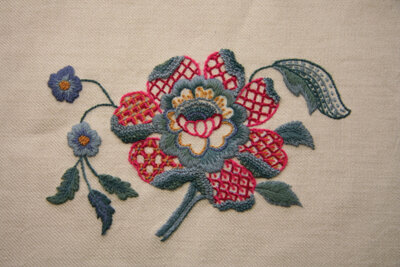 Last October I was fortunate to be able to take a class with her at Burford Needlework. The project for the class was the crewel work piece you see above. It's called the Victorian Peony and in it she's included seven different patterns of laid and couched work. She's included a few new ones in the Marriage Pillowe and that's where the serious stitching begins in that kit.After working the stem and fat, padded satin stitch berry, the next four sections to be stitched were all in laid work. This is brilliant planning for two reasons: firstly, it's good practice to work the filling stitches first and the outline stitches after that. Secondly (and very important to those of us who stitch!) laid and couched work fills up the area quickly and it looks like you accomplished a lot in a short period of time. It's a great way to begin a large project like this pillow.
Last October I was fortunate to be able to take a class with her at Burford Needlework. The project for the class was the crewel work piece you see above. It's called the Victorian Peony and in it she's included seven different patterns of laid and couched work. She's included a few new ones in the Marriage Pillowe and that's where the serious stitching begins in that kit.After working the stem and fat, padded satin stitch berry, the next four sections to be stitched were all in laid work. This is brilliant planning for two reasons: firstly, it's good practice to work the filling stitches first and the outline stitches after that. Secondly (and very important to those of us who stitch!) laid and couched work fills up the area quickly and it looks like you accomplished a lot in a short period of time. It's a great way to begin a large project like this pillow.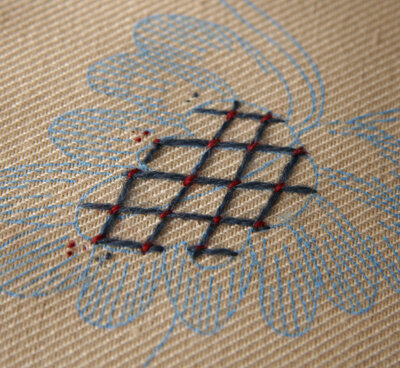 The center of this leaf is done laying long straight stitches down across a grid pattern. First all the lines are laid in one direction, then a second set of stitches is laid diagonally across the first. Next the points where the laid stitches cross are couched down (attached to the fabric) with a short straight couching stitch. Laid and couched - that's all there is to the simplest version and it looks just lovely, especially in these two rich colors.
The center of this leaf is done laying long straight stitches down across a grid pattern. First all the lines are laid in one direction, then a second set of stitches is laid diagonally across the first. Next the points where the laid stitches cross are couched down (attached to the fabric) with a short straight couching stitch. Laid and couched - that's all there is to the simplest version and it looks just lovely, especially in these two rich colors.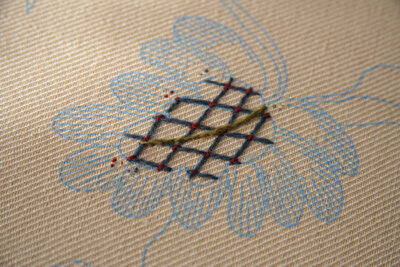 As a finishing touch, the center stem of the leaf is worked in stem stitch passing over the laid and couched work where necessary. It's done in a deep green and the combination of deep blue, red and green is beautiful.
As a finishing touch, the center stem of the leaf is worked in stem stitch passing over the laid and couched work where necessary. It's done in a deep green and the combination of deep blue, red and green is beautiful.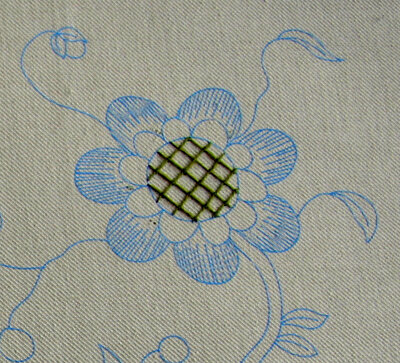 The next shape to be filled is the center of this big round flower. Again the simplest laid and couched pattern is used. The laid and couched stitches are done in a medium green. However, watch future posts for what's coming up later to jazz this area up! It's a great idea!
The next shape to be filled is the center of this big round flower. Again the simplest laid and couched pattern is used. The laid and couched stitches are done in a medium green. However, watch future posts for what's coming up later to jazz this area up! It's a great idea!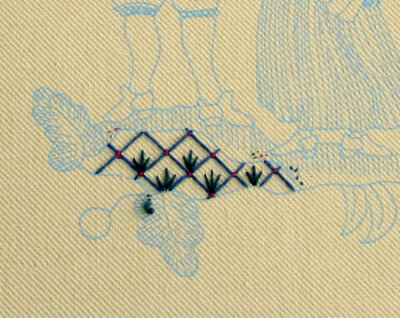 The third area to be worked in laid and couched work is the little hillock under the feet of the newlyweds. After stitching the basic grid pattern with long, laid stitches and couching the points where the lines cross, the instructions are to fill the center of the diamond shapes with three stitches - two to make a V and one up the center of the V. It looks like grass!
The third area to be worked in laid and couched work is the little hillock under the feet of the newlyweds. After stitching the basic grid pattern with long, laid stitches and couching the points where the lines cross, the instructions are to fill the center of the diamond shapes with three stitches - two to make a V and one up the center of the V. It looks like grass! Thank goodness the most difficult is the last one to do. By the time someone new to crewelwork gets to this point in the kit, he or she will have the confidence and an understanding of the method to successfully fill in this last shape. It's the most complicated, as you can see by the instructions in the photo above.
Thank goodness the most difficult is the last one to do. By the time someone new to crewelwork gets to this point in the kit, he or she will have the confidence and an understanding of the method to successfully fill in this last shape. It's the most complicated, as you can see by the instructions in the photo above.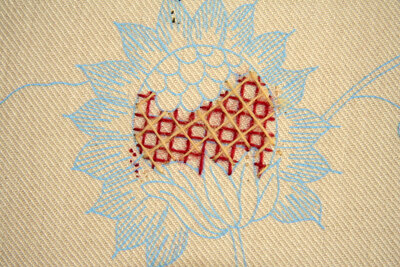 First laid stitches are put down vertically and horizontally to form the bottom gird. Then another set of laid stitches are worked diagonally in both directions to form a second grid on top of the first. Lastly, the point where the top grid threads cross one another in the middle of an empty square are couched down. The instructions are very clear and my description is short in comparison. Going step by step it was easy to follow and the result is very pretty.One great thing about laid and couched work is that it fills a shape without using much thread. I don't know if this is why it's found on many historical pieces, but I'll bet one of you knows! It seems logical...Laid and couched work - is it one of your favorite ways to fill a shape or do you use it sparingly?
First laid stitches are put down vertically and horizontally to form the bottom gird. Then another set of laid stitches are worked diagonally in both directions to form a second grid on top of the first. Lastly, the point where the top grid threads cross one another in the middle of an empty square are couched down. The instructions are very clear and my description is short in comparison. Going step by step it was easy to follow and the result is very pretty.One great thing about laid and couched work is that it fills a shape without using much thread. I don't know if this is why it's found on many historical pieces, but I'll bet one of you knows! It seems logical...Laid and couched work - is it one of your favorite ways to fill a shape or do you use it sparingly?
